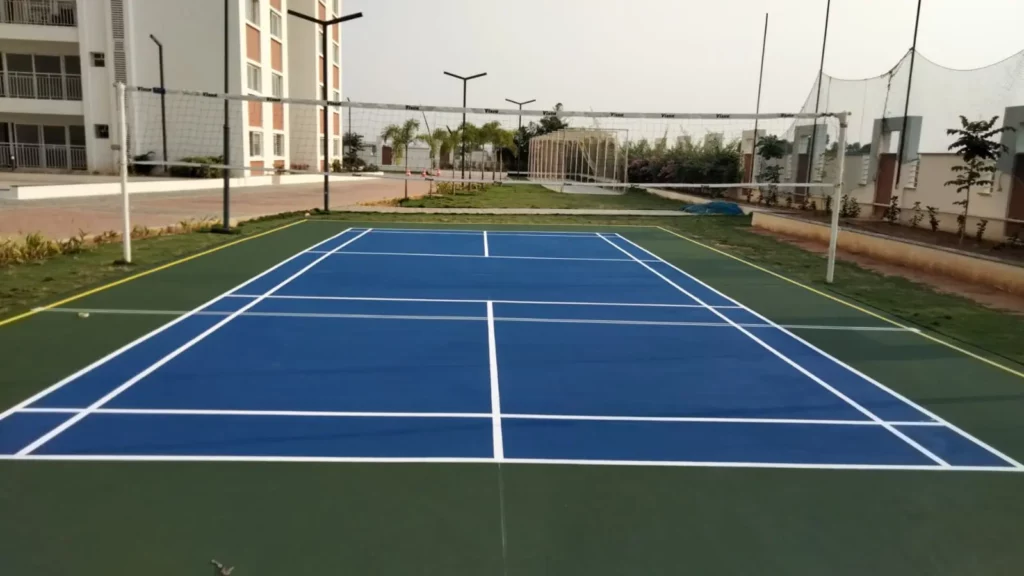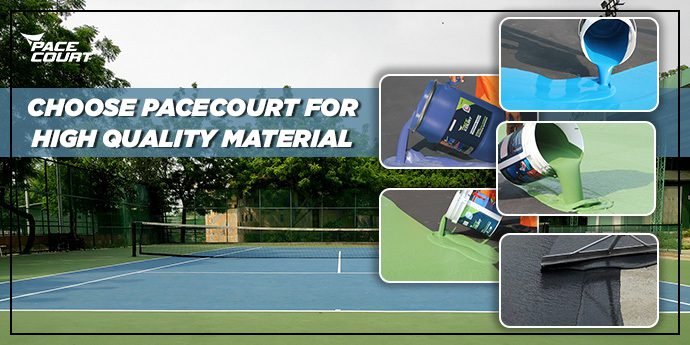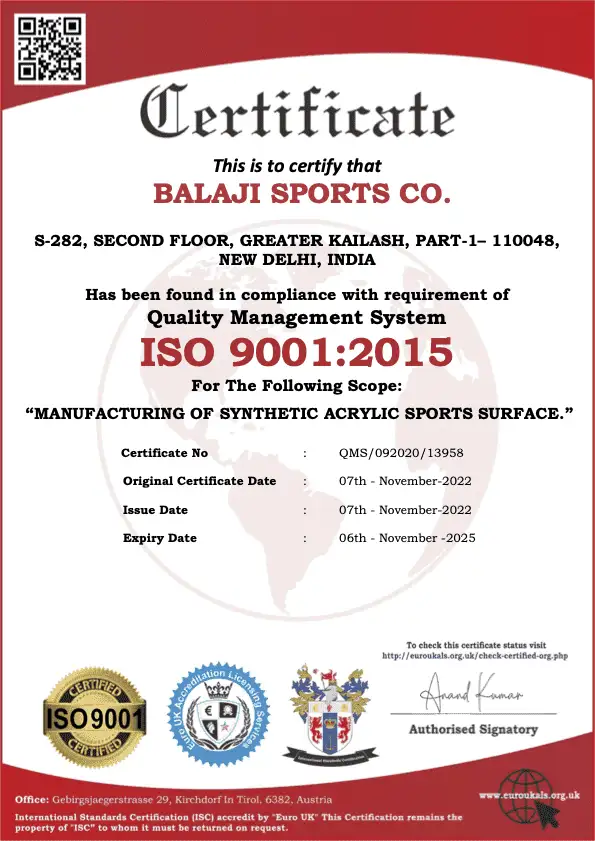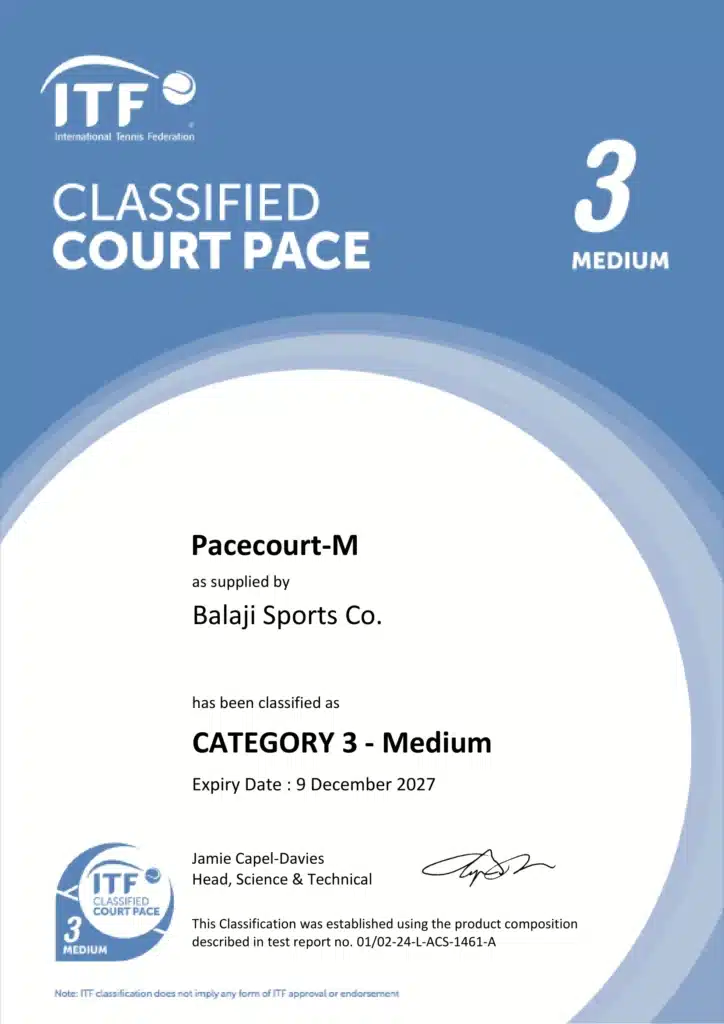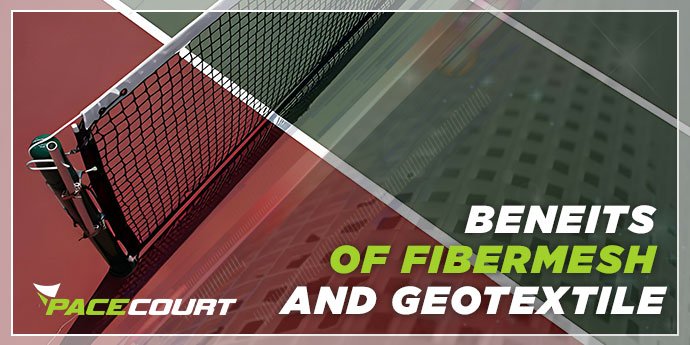
In the world of sports infrastructure, we often focus on the visible aspects of the flooring system—its texture, color, grip, and performance. But what lies beneath the surface is equally important in ensuring the safety, durability and functionality of a sports court. Two of the most underappreciated yet important components in sports flooring foundations are Fibermesh and Geotextile. These are foundation technologies that when applied correctly, enhance the structural integrity and performance of sports flooring.
Sports surfaces are exposed to constant wear, dynamic loads and weather fluctuations, having a well engineered base is very important. Fibermesh and Geotextile designed to address key challenges such as crack resistance, moisture management, soil separation and long term load distribution. Whether you use them individually or together they make a resilient and high performance sports flooring system for tennis courts, basketball arenas, multi sport surfaces and more.
This blog will explore the characteristics, benefits, applications and comparative advantages of Fibermesh and Geotextile in sports flooring systems.
What is Fibermesh?
Fibermesh is a synthetic fiber reinforcement system added to concrete or screed layers to improve their mechanical properties. Made of polypropylene, it is designed to mix uniformly within the concrete to control shrinkage and prevent micro-cracking during the curing process. Unlike traditional steel mesh, Fibermesh doesn’t require additional placement labor and integrates seamlessly with the concrete mix.
Fibermesh Properties:
- Material: Polypropylene or similar synthetic polymer.
- Fiber Type: Monofilament, fibrillated or blended.
- Tensile Strength: High resistance to tension and deformation.
- Thermal Stability: Maintains integrity under high temperatures.
- Corrosion Resistance: Fibermesh doesn’t rust or corrode like steel.
Types of Fibermesh:
- Micro Fibres: They are used for plastic shrinkage crack control.
- Macro Fibres: For long term durability and structural reinforcement.
Benefits of Fibermesh in Sports Flooring
- Crack Control: One of the main purposes of Fibermesh is to reduce plastic shrinkage cracks. As concrete dries it can crack due to rapid moisture loss. Fibermesh distributes tensile stresses and prevents micro-cracking which can later propagate into larger structural issues.
- Increased Load Bearing Capacity: Sports court flooring subjected to dynamic and repetitive loads. Fibermesh increases the tensile strength and flexural toughness of concrete so it can withstand more stress without cracking or deformation.
- Long Term Durability: Fibermesh reduces long term degradation of the base slab especially for outdoor courts exposed to environmental stressors. It performs for over a decade with minimal maintenance.
- Cost Effective Installation: Compared to steel mesh, Fibermesh requires no additional labor for placement. It reduces time and effort in the sports flooring installation process.
- Safety and Surface Integrity: A well reinforced sub-base ensures the top surface layer remains even and safe, minimizes injury risks and improves playing experience.
What is Geotextile?
Geotextile is a porous fabric used in sports flooring systems to separate, filter, reinforce and drain soil layers. It is laid between the soil and the base or beneath the concrete slab to improve the foundation.
Types of Geotextiles:
- Woven Geotextiles: They are made of weaving fibers together, and are strong and suitable for load bearing applications.
- Non-Woven Geotextiles: Made by bonding fibers chemically or thermally, they offer better drainage and filtration.
Geotextile Properties:
- Permeability: Allows water to pass through while retaining soil.
- Tensile Strength: Supports soil under stress.
- UV Resistance: Geotextile resists sunlight.
- Durability: Works for 20+ years in buried conditions.
- Chemical Resistance: They are not affected by soil chemicals, acids and alkalis.
Benefits of Geotextile in Sports Flooring
- Soil Separation: Geotextiles act as a barrier between native soil and aggregate layers. This prevents mixing of materials which can lead to uneven settlements and surface instability.
- Drainage: Non-woven geotextiles provide a path for water to drain, preventing waterlogging and surface degradation. This is especially important for outdoor courts where rain can damage the base.
- Load Distribution: By stabilizing the subgrade, geotextiles ensure uniform load distribution. This reduces localized stress and prolongs the life of both the foundation and the surface layer.
- Weed Control: When geotextiles used beneath turf or synthetic layers, also prevent weed growth, reducing maintenance and preserving surface quality.
- Frost and Thermal Protection: Geotextiles protect the sub-base from frost heave in cold climates, maintaining the integrity of the flooring system during seasonal changes.
Comparing Fibermesh and Geotextile
While both materials serve different technical purposes, they are complementary in sports flooring construction.
| Feature | Fibermesh | Geotextile |
| Purpose | Reinforced concrete/slab | Separates and stabilizes soil layers |
| Material | Polypropylene fibers | Woven or non-woven fabrics |
| Key Function | Crack control, load resistance | Drainage, filtration, soil stability |
| Placement | Mixed within concrete | Laid beneath base aggregates or slabs |
| Ideal Use | All synthetic surface base slabs | All soil-based and outdoor courts |
When used together, they offer a complete solution that addresses both structural and environmental stress factors.
Real-World Applications in Sports Flooring
- Tennis Courts: For synthetic acrylic tennis courts, a Fibermesh reinforced concrete slab, which gives a crack free and even playing surface. Below the slab a non-woven geotextile layer gives drainage and prevents soil migration.
- Basketball Courts: Outdoor basketball courts built over compacted soil benefits from geotextile stabilization, while Fibermesh strengthens the concrete base, reducing impact induced cracking.
- Multipurpose Courts: These courts are used for various sports and require a stable all-weather surface. The combined use of Fibermesh and Geotextile gives high performance, low maintenance and long life.
- Running Tracks and Athletic Surfaces: In these systems geotextile gives proper water runoff, while a Fibermesh layer supports the base under constant foot traffic and movement.
Installation Guidelines of Fibermesh and Geotextile in Sports Flooring

Fibermesh (Concrete Reinforcement)
- Determine the Right Quantity Based on Court Load
- 0.9 to 1.2 kg of Fibermesh per cubic meter of concrete but check the manufacturer’s specifications based on slab thickness, court type (e.g. tennis vs. multipurpose) and expected load.
- For high traffic courts, slightly higher dosage may be recommended.
- Add Fibermesh During Concrete Batching
- Introduce Fibermesh into the concrete mix at the on-site into the concrete mixer before pouring.
- Don’t add all the fibres at once to avoid clumping. Feed them gradually while mixing.
- Ensure Uniform Fiber Distribution with Mechanical Mixing
- Use a mechanical drum mixer or pan mixer to get homogeneous fiber dispersion in the concrete mix.
- Poorly mixed fibers can result in weak spots or uneven surface integrity.
- Pour and Level the Concrete Normally Using Standard Tools
- Pour the concrete mix using conventional methods.
- Screed and finish the slab using bull floats or trowels as per standard RCC practices.
- Cure Properly for Long Term Strength Development
- Start curing within 2–4 hours of final finishing.
- Cure with wet curing (water ponding or wet burlap) or curing compounds for at least 7 days, preferably 14–28 days.
- Proper curing is essential to activate the reinforcing effect of Fibermesh and prevent premature surface cracking.
For Geotextile (Subgrade Stabilization and Drainage)
- Excavate and Compact the Site to Required Depth
- Remove the topsoil, organic matter, and loose debris.
- Excavate up to 300–450 mm, depending on the court type and soil quality.
- Compact the soil using a vibratory roller or plate compactor to achieve at least 95% Proctor density.
- Lay the Geotextile Fabric Over the Compacted Subgrade
- Choose non-woven geotextile fabric (preferably 250–300 GSM for sports courts).
- Unroll the fabric across the entire area with the smooth side facing up (if directional).
- Ensure the fabric follows the ground contours without tension or floating areas.
- Overlap Edges by At Least 30–50 cm with No Gaps
- Overlap side-by-side sheets by minimum 30 cm (or 50 cm for weak soil conditions).
- Use fabric clips, stitching, or heat-welding (optional) for high-performance installations.
- Avoid wrinkles, folds, or tears during placement.
- Secure the Geotextile to Prevent Shifting
- Use U-shaped steel pins or plastic anchors every 1.0–1.5 meters, especially around edges and overlaps.
- On windy or sloped sites, use temporary ballast (sandbags or gravel) to hold fabric in place before adding aggregate.
- Add and Compact Aggregate Base Material Over the Fabric
- Place GSB (Granular Sub-Base) or WBM (Water Bound Macadam) over the fabric.
- Spread uniformly in 2–3 layers, each 50–75 mm thick.
- Compact each layer using a vibratory roller to ensure interlocking and base strength.
Sustainability and Environmental Impact
Fibermesh and Geotextile are part of sustainable construction:
- Less Resource Use: Fibermesh eliminates steel mesh, reducing metal usage and transport costs.
- Longer Life: Surfaces built with these materials last longer and need fewer repairs.
- Water Management: Geotextile fabrics drain better, less water wastage and erosion.
- Recyclable: Both materials are made from polymers that can be recycled, less waste.
Conclusion
In summary, while players and spectators may never see them, Fibermesh and Geotextile in sports flooring are the behind the scenes heroes of modern sports flooring systems. Their ability to stabilize, reinforce and protect the layers beneath synthetic courts is crucial. For contractors, architects and facility owners looking to build long lasting high performance sports infrastructure, using these materials is not just an option – it’s a best practice.
Choosing the right combination of Fibermesh and Geotextile gives you a foundation that performs under stress, drains well and stands the test of time. As the demand for quality sports flooring grows, so will the relevance of these foundation technologies in building the courts of tomorrow.
Frequently Asked Questions
Non-woven geotextiles commonly used in sports flooring systems due to their superior drainage and separation properties.
Fibermesh over traditional reinforcement in sports flooring is quicker to apply, reduces labor costs, minimizes shrinkage cracks, and offers multidirectional reinforcement.
Absolutely. They serve different purposes—geotextile for sub-base separation and drainage, and fibermesh for concrete reinforcement—making them a powerful combination.
Its not mandatory, geotextile is highly recommended for outdoor courts like tennis, basketball, and multi-sport surfaces to improve stability and water drainage.
Geotextiles help facilitate proper drainage by allowing water to pass through while preventing soil movement, avoiding waterlogging under the court.
Typically, 200–400 GSM non-woven geotextiles are used depending on soil conditions and expected load from the sports activity.


